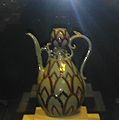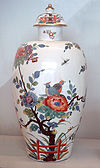- Korean pottery and porcelain
-
Korean ceramic history begins with the oldest earthenware from around 8000 BC.
Contents
History
Three Kingdoms pottery
 pottery of the Gaya confederacy.
pottery of the Gaya confederacy.
Goryeo Dynasty porcelain
The Goryeo Dynasty (918–1392) achieved the unification of the Later Three Kingdoms under King Taejo. The works of this period are considered by some to be the finest small-scale works of ceramics in Korean history.
Key-fret, foliate designs, geometric or scrolling flowerhead bands, elliptical panels, stylized fish and insects, and the use of incised designs began at this time. Glazes were usually various shades of celadon, with browned glazes to almost black glazes being used for stoneware and storage. Celadon glazes could be rendered almost transparent to show black and white inlays.
While the forms generally seen are broad-shouldered bottles, larger low bowls or shallow smaller bowls, highly decorated celadon cosmetic boxes, and small slip-inlaid cups, the Buddhist potteries also produced melon-shaped vases, chrysanthemum cups often of spectacularly architectural design on stands with lotus motifs and lotus flower heads. In-curving rimmed alms bowls have also been discovered similar to Korean metalware. Wine cups often had a tall foot which rested on dish-shaped stands.
Joseon Dynasty porcelain
See also: Joseon white porcelain and BuncheongDuring the Joseon Dynasty, (1392–1910) ceramic ware was considered to represent the highest quality of achievement from imperial, city, and provincial kilns, the last of which were export-driven wares. This was the golden age of Korean pottery, with a long period of growth in imperial and provincial kilns, and much work of the highest quality still preserved.
Wares evolved along Chinese lines in terms of colour, shape, and technique. Celadon, white porcelain, and storage pottery were similar, but with slight variations in glazes, incision designs, florality, and weight. The Ming influence in blue and white wares using cobalt-blue glazes existed, but without the pthalo blue range, and the three-dimensional glassine colour depth of Ming Dynasty Chinese works.
Simplified designs emerged early on. Buddhist designs still prevailed in celadon wares: lotus flowers, and willow trees. The form most often seen was that of pear-shaped bottles. Notable were thinner glazes, and colourless glazes for buncheong or stoneware.
After the prolonged fall of the Ming dynasty, immigration of some Chinese master potters occurred in southern coastal Korea. Qing colouring, brighter and almost Scythian in enamel imitation, was rejected by Korean potters, in favour of simpler, less decorated wares in keeping with a new dynasty that built itself on military tradition.
Generally, the ceramics of this dynasty is divided into early, middle, and late periods, changing every two centuries, approximately; thus 1300 to 1500 is the early period, 1500 to 1700 the middle, and 1700 to 1900–1910 the late period.
The wares began to assume more traditional Korean glazes and more specific designs to meet regional needs. This is to be expected, as the Scythian art influences were of the former dynasty. The rise of white porcelain occurred as a result of Confucian influence and ideals, resulting in purer, less pretentious forms lacking artifice and complexity.
In 1592 during the Japanese invasion of Korea, entire villages of Korean potters were forcibly relocated to Japan permanently damaging the pottery industry as craftsmen had to relearn techniques because the masters were gone. [1]
Export porcelain
Nearly all exports of Korean ceramics went to Japan, and most were from provincial coastal kilns, especially in the Busan area. Export occurred in two ways: either through trading and the voluntary immigration of potters, or through outright invasion and theft of pottery and the forced relocation to Japan of families of potters who made the wares. The method of sending paper models of ceramics to Japan, having them approved and then having them manufactured began in the late 17th century, most often for the masters of Japanese Tea Ceremony.
Kilns
 A kiln in Yangdong Village of Gyeongju.
A kiln in Yangdong Village of Gyeongju.
Central to Korean success were the chambered climbing kilns that were used throughout the Joseon dynasty and exported abroad, especially to Japan by Korean kiln-makers where they were renamed as noborigama in the Karatsu area from the 17th century on.
Modern kilns are either electric or gas-firedre electric kilns.
Centers For studying Korean ceramics
- Department of Ceramics at the College of Art and Design, Ewha Woman's University in Seoul
- Korea Ceramic Foundation (KOCEF)
Gallery
See also
References
- Goro Akaboshi, Five Centuries of Korean Ceramics, Weatherhill, 1975.
External links
- The Asian Art Museum, An excellent Korean ceramics collection
- The Art of Korean Potters Exhibit
- Korean History
- Over 120 pictures of Korean Pottery from the Freer Gallery
- Koryo dynasty
- Korean ceramics Details of an exhibition at the Smithsonian Institution
- Cultural Assets of Korea
- Comprehensive Archaeological Bibliography of Korean Pottery
- Talks on the Korean impact on Japanese ceramics (Archived 2009-10-31)
- Joseon Dragon vase (Archived 2009-10-31) with softer watery-blue glaze and naturalistic brush-strokes
- From the Fire: Contemporary Korean ceramics International Arts Ceramic Artists exhibition
- Mountain Dreams: Contemporary Ceramics by Yoon Kwang-cho — Philadelphia Museum of Art exhibition
Porcelain China Chinese porcelain · Chinese export porcelain · Chinese influences on Islamic pottery
Types: Proto-celadon (16th century BCE) · Celadon (1st century) · Yue (2nd century) · Jingdezhen (6th century) · Sancai (8th century) · Ding (10th century) · Qingbai (12th century) · Blue and white (14th century) · Blanc de Chine (14th century) · Kraak (16th century) · Swatow (16th century) · Kangxi (17th century) · Famille jaune, noire, rose, verte (17th century) · Tenkei (17th century) · Canton (18th century)Korea Korean porcelain
Types: Joseon (14th century)Japan Europe French porcelain · Chinese porcelain in European painting
Types: Fonthill Vase (1338) · Medici (1575) · Rouen (1673) · Nevers · Saint-Cloud (1693) · Meissen (1710) · Chantilly (1730) · Vincennes (1740) · Chelsea (1743) · Oranienbaum (1744) · Mennecy (1745) · Bow (1747) · Nymphenburg Porcelain Manufactory (1747) · Plymouth (1748) · Worcester (1751) · Frankenthal Porcelain Factory (1755) · Sèvres (1756) · Derby (1757) · Wedgwood (1759) · Wallendorf (1764) · Etiolles (1770) · Limoges (1771) · Clignancourt (1775) · Royal Copenhagen (1775) · Revol (1789) · Herend Porcelain Manufactory (1826) · Zsolnay (1853)Technologies People Ehrenfried Walther von Tschirnhaus · Johann Friedrich Böttger · Francois Xavier d'Entrecolles · Dmitry VinogradovCollections British Museum (London): Asia Department / Percival David Foundation · Dresden Porcelain Collection · Gardiner Museum (Toronto) · Kuskovo State Museum of Ceramics (Moscow) · Musée national de Céramique-Sèvres (Paris) · Musée des Arts Décoratifs (Paris) · Palace Museum (Beijing) · Topkapı Palace (Istanbul) · Victoria and Albert Museum (London) · Worcester Porcelain MuseumMaterials Techniques Processes Burnishing • RAM pressing • Slipcasting • Glazing • Firing • Bisque firing • Saggar firing • Pit firingProducts Studio pottery • Salt glaze pottery • Delftware • Ceramics of indigenous peoples of the Americas • Iranian pottery • Kakiemon • Poole Pottery • Jasperware • Korean ceramics • Mexican ceramics • Rockingham Pottery • Sea pottery • SlipwareNotable potters Potters by nationalityCategories:- Korean pottery
Wikimedia Foundation. 2010.














